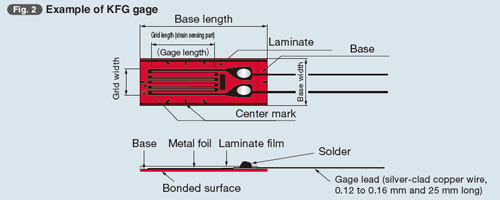Principle of Strain Gages
Principle of Strain Gages
Each metal has its specific resistance. An external tensile force /(compressive force) increases/decreases the resistance by elongating/contracting it. Suppose the original resistance is R and a strain initiated change in resistance is ź─R. Then, the following relation is concluded:
where, Ks is a gage factor, the coefficient expressing strain gage sensitivity. General purpose strain gages use copper-nickel or nickel-chrome alloy for the resistive element, and the gage factor provided by these alloys are approximately 2.
Types of Strain Gages
Types of strain gages include foil strain gage, wire strain gage, and semiconductor strain gage.
Structure of Foil Strain Gage
The foil strain gage has metal foil photo-etched in a grid pattern on the electric insulator of the thin resin and gage leads attached, as shown in Fig. 2 below.
The strain gage is bonded to the measuring object with a dedicated adhesive. Strain occurring on the measuring site is transferred to the strain sensing element via the gage base. For accurate measurement, the strain gage and adhesive should match the measuring material and operating conditions including temperature.











 TOP
TOP